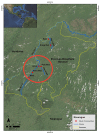Fur Color and Nutritional Status Predict Hair Cortisol Concentrations of Dogs in Nicaragua
- PMID: 33195542
- PMCID: PMC7604343
- DOI: 10.3389/fvets.2020.565346
Fur Color and Nutritional Status Predict Hair Cortisol Concentrations of Dogs in Nicaragua
Abstract
This study examined the relationships between hair cortisol concentrations (HCC) and sex, age, nutritional status (as determined by body condition scores, or BCS), and body mass (geometric mean calculated from morphometric measurements), as well as the potential influence of hair pigmentation (light, dark, or agouti/mixed) on HCC in dogs of the Bosawas Biosphere Reserve, Nicaragua. The dogs examined in this study live in a marginal environment where disease, malnutrition, and mortality rates are high. For fur color, HCC was significantly higher in light fur than in than dark and mixed fur (p < 0.001). In addition, BCS scores were found to have a negative effect on HCC (p < 0.001). Measures of sex and body size exhibited inconclusive effects on HCC, and when compared to adult dogs, juvenile dogs did not exhibit significantly different HCC. Repeated measures of dogs over time reveal a moderate intra-class correlation, suggesting that there are unmeasured sources of individual-level heterogeneity. These findings imply a need to account for fur color in studies of HCC in dogs, and the study suggests an overlooked relationship between cortisol and body condition scores in undernourished dogs in diverse settings.
Keywords: canine health; canine nutrition; cortisol and metabolism; hair cortisol concentrations; hair pigmentation; stress energetics in working dogs.
Copyright © 2020 Bowland, Bernstein, Koster, Fiorello, Brenn-White, Liu, Schwartz, Campbell, von Stade, Beagley, Pomerantz, González, Quick, McKinnon, Aghaian, Sparks and Gross.
Figures





References
-
- Fink G. Stress: definition and history. In: Encyclopedia of Neuroscience. Oxford: Academic Press; (2009). p. 549–55. 10.1016/B978-008045046-9.00076-0 - DOI
-
- Selye H. Physiology of stress. In: Quinn NL, Flagg AL, editors. Jacqueline Mark-Geraci, Julie Champagne Bolduc, Advanced Clinical Insights. 5th Ed Sudbury: Jones and Bartlett Publishing; (2002). p. 35–48.
LinkOut - more resources
Full Text Sources

